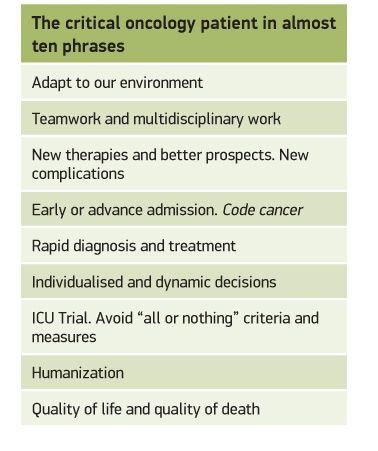Recent advances and new challenges.
It has been thought for years that cancer patients have not benefitted from intensive care unit (ICU) admission when they suffer from severe and potentially reversible acute illnesses. Fortunately, numerous studies have shown that this is not the case. Today, the number of cancer patients in ICUs around the world is increasing every year, and both survival and quality of life are improving in the same manner. This progress is due to multiple factors, from progress in anti-tumour treatments to better management of patients in the ICU.
We are moving towards an individualised and dynamic treatment that will be adapted to the type of tumour and the patient's immune response. The prognosis of the critical cancer patient is time-dependent and therefore ICU intensivists must face the challenge of making a good selection of patients with early admission and effective diagnosis and treatment.
Oncological and haematological disease is one of the leading causes of morbidity and mortality in the world (Azoulay et al. 2013). The percentage of cancer patients in ICU varies between 6% and 20% (Bos et al. 2015; Shimalbukuro-Vornhagen et al. 2016), in many cases lower than that of other less prevalent pathologies. Approximately 50% of these admissions are due to surgical procedures, while the other 50% is related to medical causes, with only 3.3% corresponding to specific causes of oncological disease (Puxty et al. 2015).
Considering that cancer treatments have increased their efficacy, associated with better prognosis and increased life expectancy, it is foreseeable that the number of cancer patients requiring admission to ICU will continue to increase in the coming years, constituting a field of compulsory continuous training for intensivists.
Observational studies have shown an improvement, not only in terms of mortality, but also in terms of the quality of life of cancer patients who have required admission to the ICU. However, this is still noticeably worse than that of the general population, both at 3 and 12 months after hospital discharge, especially in haematological patients. Old age, poor functional status prior to admission to the ICU, and a higher degree of multi-organ failure during the ICU stay are independent predictors of poorer quality of life.
In our area, we now have available a recent study series that includes a mixed population of onco-haematological patients admitted to ICU, with 36% mortality and 40% dependence on discharge (Díaz-Díaz et al. 2018). A study conducted in France showed similar clinical outcomes, with hospital mortality rates, 3-month mortality and one-year mortality of 39%, 47% and 57% respectively (Azoulay et al. 2013). These results are far removed from the classical studies, which presented unacceptably high mortalities that did not justify aggressive management of these populations (Hauser et al. 1982).
The improvement in the prognosis of cancer patients in ICU is undoubtedly multifactorial. Knowledge of these factors is fundamental to patient management and a challenge for future improvement. We can highlight five key elements:
1) New anti-tumour therapies
The medical and surgical treatment of cancer patients has changed considerably. Chemotherapy in ICU, unthinkable until relatively recently, may be a therapeutic option in selected critical patients. Treatment increasingly targeted at tumour cells as evidenced by immunotherapy (monoclonal and bispecific antibodies (BABs), chimeric antigen receptor (CAR) T cells, and checkpoint inhibitors) is, in general, effective and well tolerated. These therapies have also led to the appearance of new complications associated with the treatment that the intensivist must know about and treat, such as cytokine-release syndrome, which can simulate sepsis or anaphylaxis and whose treatment can be very different.
Laparoscopic (keyhole) surgery has decreased the time and postoperative complications of many tumours. Even the most aggressive techniques such as cytoreductive surgery and heated intraperitoneal chemotherapy require a short stay in ICU when performed by experienced teams.
2) Criteria for admission to ICU
We are getting a better selection of patients who can benefit from admission to the ICU. This is due to, among other reasons, greater collaboration by oncologists, haematologists and intensivists, with the development of management protocols and agreements on admission criteria (Carmona-Bayonas et al. 2018).
The decision whether or not to admit a cancer patient to the ICU is a difficult one, and both the potential benefit and the possibility of the treatment being unsuccessful should be taken into account. The admission of an oncology patient to ICU should be based on three principles:
- The reason for admission must be reversible
- The patient shows an adequate quality of life and the prognosis of the oncological disease and its therapeutic possibilities justify the use of aggressive measures
- The patient or his/her family members do not refuse admission.
The prognosis of cancer patients in the ICU, as well as those with non-oncological conditions, depends on the performance status, the severity of the acute illness and the number of organ systems that fail. Oncological diagnosis, the stage of the tumour, neutropaenia, aplasia or the presence of metastasis have little or no relevance to the short-term prognosis of a cancer patient in ICU. In general, cancer patients have a worse prognosis than non-cancerous patients in ICU, especially those with haematologic malignancies. This is probably due to being an immunocompromised patient and not having cancer “per se.” If we could determine the immunosuppression status of critical patients in routine clinical practice, we would see a good correlation between that status and the prognosis. Over the next few years, the increased knowledge of the immune response in critical cancer patients, the possibility of obtaining real-time data and the possibility of therapeutically modulating this response will represent an unprecedented advance in improving survival.
Traditional prognostic scores have very limited value in cancer patients and only scores that assess organic function (sequential organ failure assessment [SOFA], Logistic Organ Dysfunction Score [LODS]), better predict mortality and are useful in making decisions. The short-term prognosis is mainly associated with the number of dysfunctional organs (especially if more than 3), the need for invasive mechanical ventilation (IMV) and the need for renal replacement therapy.
3) Speed and precision
Cancer patients have varying degrees of immunosuppression, making them more likely to have conditions, not just infectious ones, during their illness and to respond negatively to these complications. Even minor organ dysfunctions have been associated with an increase in mortality, thus making early admission to the ICU a better prognostic determinant (Legrand et al. 2012). It is especially relevant when the oncology patient is admitted to the ICU with sepsis or acute respiratory failure (Hanzelka et al. 2013; Mokart et al. 2013). In high-risk patients we should consider the risk/benefit of preventative admission to ICU.
The speed with which the appropriate treatment is put in place will have a significant influence on prognosis. The creation of extra-ICU rapid response teams, extra-ICU patient assessment teams or specific projects for certain pathologies (sepsis code) has led to progress in this area.
In a large number of critical cancer patients we do not have a reliable diagnosis and these patients have a worse prognosis. Noninvasive or minimally invasive diagnostic techniques such as computed tomography (CT), lung and heart ultrasound, haemodynamic monitoring by thermodilution and/or pulse wave analysis and early analysis of samples taken by bronchoscopy (bronchoalveolar lavage and tracheal aspirate) should be the cornerstone of early diagnosis.
In the group of acute time-dependent pathologies in which an improvement in prognosis has been demonstrated with rapid action protocols: code myocardial infarction, code stroke or code sepsis, there are also complicated oncology patients. Why not a code cancer if we have to be especially precise and quick in our diagnostic and therapeutic response to cancer patients?
4) Improving support measures in ICUs
This is especially true for respiratory support, both noninvasive mechanical ventilation (NIMV) and high-flow nasal cannula oxygen (HFNC). The need for tracheal intubation and IMV has been considered the main risk factor for short-term mortality in onco-haematological patients admitted to the ICU. Despite the improvement in survival due to the application of protective mechanical ventilation, and based on different clinical studies (Squadrone et al. 2010; Lemiale et al. 2015), NIMV has been recommended as the initial treatment for respiratory failure in these patients, since it significantly reduces the need for tracheal intubation and IMV, avoiding its associated complications and improving prognosis.
However, a new multicentre study (Lemiale et al. 2015) was published in 2015, including the largest number of patients to date, which sought to demonstrate the possible beneficial effects of NIMV on this population of patients. Despite the criticism received (less severe acute respiratory failure based on lower respiratory rate, low mortality of the sample, few hours of NIMV) the study found no significant clinical differences when using NIMV as a first therapeutic possibility. In both branches of this study, HFNC was used in nearly 40% of the cases, which allows us to hypothesise whether the best approach for these patients is a joint use of both systems.
In recent retrospective trials (Mokart et al. 2015), this approach has been associated with a reduction in mortality, although it is necessary to wait for the results of new clinical studies before drawing definitive conclusions. In any case, and as the study by Kangelaris et al. (2016) highlights, it is important to remember that in patients who choose a noninvasive ventilatory strategy, and who subsequently require tracheal intubation, mortality is significantly higher in both the short and long term; therefore, we should not delay invasive support in the case that it is required.
5) ICU trial
In the group of patients about whom we have questions as to the attitude to be taken, it would be advisable to carry out an ICU trial, this being understood as admission to the ICU without therapeutic restrictions for at least 72 hours, with frequent and periodic re-evaluations, with the intention of not perpetuating unnecessary treatments and prolonging the suffering of the patients and their families.
The ICU trial is based on a study published by Lecuyer et al. (2007), in which they found no statistically significant variables at the time of admission to the ICU that differentiated between survivors and non-survivors. However, after 72 hours none of the patients who required increased organ support measures survived. Thus, if after that time, the patient experiences failure of 3 or more organs or worsening of the previous multi-organ failure, vital expectations are minimal and it would be advisable to establish measures to limit the therapeutic effort (Prieto del Portillo et al. 2014).
Thus, not only do we avoid unnecessary treatment or suffering of family members, but we will also participate in the prevention of conflicts between ICU staff members and the emergence of burnout syndrome (Piers et al. 2011).
Admission to ICU does not necessarily imply taking all necessary measures for as long as possible. We must take into account a wide range of possibilities. We can admit patients with the intention of giving unrestricted treatment for at least five days and reassess it according to its evolution. We can enter for haemodynamic or renal support and limit IMV. We can even check in to optimise comfort measures or reduce dyspnoea with high-flow nasal goggles or IMV for patients with poor prognosis. Here, too, decisions must be made in a multidisciplinary manner (intensivists, oncologists and haematologists) and in agreement with the patient and family members.
All therapeutic options can be considered and individualised, including those that have traditionally been considered limiting factors, such as chemotherapy in ICU or extracorporeal membrane oxygenation (ECMO) in patients with severe refractory respiratory failure. Subgroups with poorer prognosis, such as patients with severe allogenic bone marrow transplant and graft versus host disease (GVHD) or patients with lung neoplasms requiring mechanical ventilation for respiratory failure and who may require chemotherapy in ICU, may also benefit from admission to ICU.
Conclusions
For many years ICUs have focused on the treatment of acute illness and neglected the emotional side of patients and families. This is most evident in cancer patients. We must humanize ICUs, make them open to family members, minimise noise, integrate psychologists into our work teams, respect the circadian rhythm of patients and make the environment less inhospitable and more hospitable.
We are moving towards individualised treatment for cancer patients and this also requires us to adopt individualised and dynamic support measures. Admission criteria and therapeutic measures in ICUs should no longer be "all or nothing" and should be adapted to each patient and their wishes. The ICU must also be able to provide quality at the end of life. Undoubtedly, the human and technical resources available to us vary greatly between centres and countries, so we must also adapt to our working environment.
Conflict of interest
Isidro Prieto del Portillo declares that he has no conflict of interest. Ignacio Sáez de la Fuente declares that he has no conflict of interest. Ignacio Pujol Varela declares that he has no conflict of interest.










